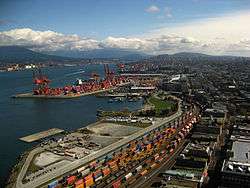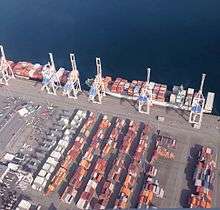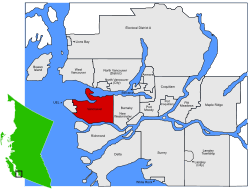Vancouver Fraser Port Authority
The Vancouver Fraser Port Authority,[2] responsible for overseeing the Port of Vancouver, Canada's largest port and the third largest in North America by tonnes of cargo, facilitating trade between Canada and more than 170 world economies. It is the principal authority for shipping and port-related land and sea use in the Metro Vancouver region. In 2014, the Port of Vancouver was the fourth largest port by tonnage in the Americas,[3] 29th in the world[3] in terms of total cargo and 44th in the world by container traffic.[3] The Vancouver Fraser Port Authority was established by the Government of Canada in January 2008 and is responsible for the stewardship of the federal port lands in and around Vancouver, British Columbia. It is financially self-sufficient and accountable to the federal minister of transport and operates pursuant to the Canada Marine Act. The port authority and port terminals and tenants are responsible for the efficient and reliable movement of goods and passengers, integrating environmental, social and economic sustainability initiatives into all areas of port operations. Enabling the trade of approximately $240 billion in goods, port activities sustain 115,300 jobs, $7 billion in wages, and $11.9 billion in GDP across Canada.[4]
| Port of Vancouver | |
|---|---|
 | |
| Location | |
| Country | Canada |
| Location | Vancouver, British Columbia |
| Coordinates | 49°16′37″N 123°07′15″W |
| Details | |
| Opened | 2008 (as amalgamation of former Port of Vancouver, North Fraser Port Authority and Fraser River Port Authority) |
| Size of harbor | 16,000 hectares |
| Land area | 1,000 hectares |
| Size | 350 kilometres |
| Chair | Judy Rogers |
| Statistics | |
| Annual cargo tonnage | 147 million metric revenue tons[1] |
| Annual container volume | 3.4 million TEU[1] |
| Value of cargo | $240 billion CAD[1] |
| Passenger traffic | 889,162 passengers 241 sailings[1] |
| Foreign vessel calls | 3,145[1] |
| Major marine terminals | 27 |
| Website www | |
History
Merger
Prior to the formation of the new authority, there were three separate port authorities in the Metro Vancouver region: the Port of Vancouver, which was the largest port in Canada; the Fraser River Port Authority; and the North Fraser Port Authority.
Although the ports were financially self-sufficient, the federal legislation governing the authorities generated some inefficiency because the port authorities, legally separate entities, were forced to compete with each other economically for business. This inefficiency came to the attention of the local media in 2006 when it was found that the recently expanded Fraser Surrey Docks, operated by the Fraser River Port Authority in New Westminster, were sitting idle after their principal shipping partner, CP Ships, relocated to the Port of Vancouver, already nearing capacity.[5] Some critics opposed the possible merger as they felt the new authority would not recognize the unique concerns of the Fraser River.[6]
To increase the efficiency of the ports of Metro Vancouver, the federal Minister of Transport permitted the three authorities to study the benefits of amalgamating in June 2006. The resulting report highlighted several benefits of amalgamation, and on June 16, Transport Canada granted a "certificate of intent to amalgamate port authorities". On December 21, 2007, the government of Canada published a certificate of amalgamation that allowed the three port authorities to merge into one effective January 1, 2008.[7] The resulting entity became known as Port Metro Vancouver.
Since 2013, the Vancouver Fraser Port Authority also merged with Canada Place Corporation, which formerly operated Canada Place as a subsidiary of Port of Vancouver.[8]
On April 6, 2016, the port authority dropped "Port Metro Vancouver" from its branding and re-adopted "Port of Vancouver" to refer to Vancouver's port, while using "Vancouver Fraser Port Authority" when referencing activities or decisions of the port authority.[2]


Major initiatives
Container Capacity Improvement Program
The Container Capacity Improvement Program (CCIP) is the port's long-term strategy to meet anticipated growth in container traffic, which is expected to triple by the year 2030. The program consists of projects that both improve the efficiency of existing infrastructure and explore opportunities to build new infrastructure as demand rises. CCIP projects include the Deltaport Terminal Road and Rail Improvement Project (DTRRIP) and the proposed Roberts Bank Terminal 2 project.[9]
DTTRIP will result in infrastructure upgrades that would increase Deltaport's container capacity by 600,000 TEUs (twenty-foot equivalent units), within the terminal's existing footprint. The Roberts Bank Terminal 2 project is a proposed marine container terminal that could provide an additional capacity of 2.4 million TEUs per year to meet forecasted demand until 2030.[10]
North Shore Trade Area projects include:
- Western Level Lower Level Route Extension
- Pemberton Avenue Grade Separation
- Low Level Road Realignment[11]
- Neptune/Cargill Grade Separation
- Brooksbank Avenue Underpass[12]
- Lynn Creek Rail Bridge Addition [12]
South Shore Trade Area projects include:
- Powell Street Grade Separation
- Stewart Street/Victoria Overpass

Business sectors
Port of Vancouver offers 28 deep-sea and domestic marine terminals that service five business sectors: automobiles, break-bulk, bulk, containers, and cruise.
Terminals and facilities
Automobile terminals
- Wallenius Wilhelmsen Logistics
- Fraser Wharves (ceased operations at end of 2013)
Break-bulk terminals
- Fraser Surrey Docks
- Lynnterm East Gate and West Gate
Bulk terminals
- Alliance Grain Terminal
- Canexus Chemicals
- Cargill
- Cascadia
- Fibreco
- Ioco
- Kinder Morgan Vancouver Wharves
- Kinder Morgan Westridge
- Lantic Inc.
- Neptune Bulk Terminals
- Pacific Coast Terminals
- Pacific Elevators
- Petro-Canada
- Richardson International
- Robert's Bank Coal Terminals
- Shellburn
- Stanovan
- Univar Canada Terminal
- West Coast Reduction
- Westshore Terminals
Cruise terminals
- Ballantyne Pier (ceased cruise operations at end of 2014 [13])
- Canada Place
Gallery
 Ship loading sulfur (brimstone).
Ship loading sulfur (brimstone). Warehouse to stock goods before or after loading.
Warehouse to stock goods before or after loading..jpg) Korean statue at Port Vancouver.
Korean statue at Port Vancouver.
See also
- History of Squamish and Tsleil-Waututh longshoremen, 1863-1963
- List of ports and harbors of the Pacific Ocean
References
- "Wayback Machine" (PDF). 13 March 2014. Archived from the original (PDF) on 13 March 2014.
- "Port authority makes name change to provide clarity ", Port of Vancouver
- [American Association of Port Authorities - World Port Rankings (2016) http://aapa.files.cms-plus.com/Statistics/WORLD%20PORT%20RANKINGS%202016.xlsx]
- "2008 PMV Economic Impact Study".
- "Container docks in Surrey idle after $190m expansion - The Vancouver Sun".
- "Port authorities set to amalgamate - Delta Optimist".
- Archived 2009-01-23 at the Wayback Machine About Us - Port Metro Vancouver
- "Canada Place Corporation".
- "Port poised to begin expansion talks in earnest". Archived from the original on February 5, 2013. Retrieved November 28, 2012.
- Gyarmati, Sandor. "Deadline for feedback on T2 is drawing near".
- Port Metro Vancouver. Port Metro Vancouver. Retrieved on 2014-04-12.
- Port Metro Vancouver. Port Metro Vancouver (2011-03-29). Retrieved on 2014-04-12.
- Kalosh, Anne. "Vancouver eyes strong season, the last for Ballantyne as cruise moves fully to Canada Place".